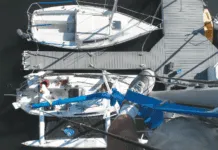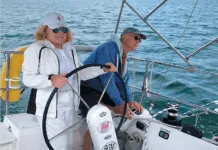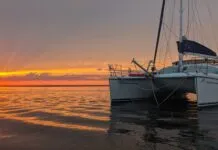Shockles
Shockles are new, introduced late last summer by a company in Hood River, Oregon. You might say Shockles are a glorified version of what campers and truckers call “tie-downs,”which are various arrangements of shock cord with bent-wire or plastic hooks. Or an easier-to-rig version of a plain rubber snubber. Or a more versatile gadget than, say, Tempo’s Line-Master (because the Shockle has hooks on the ends).

A Shockle’s primary use is in a mooring line or anchor line. However, it also can serve as a boom stabilizer or preventer; to lash a tiller; for dinghy towing; to secure the dinghy on deck, or for more esoteric purposes like on the tack of an asymmetrical headsail (to handle gusts).
As shown in the photos, the heart of a Shockle is a double loop of tough shock cord, covered with a nylon sleeve and securely fastened with both a knot and wire clips.The double loop’s ends are left exposed to mount a pair of anodized aluminum carabiners with stainless pins. The modified “D” shape of the carabiner places the load on the non-gate side and leaves the spring-loaded gate free to work under tension, if need be.
Finally, the entire assembly is covered with nylon web tubing long enough to permit the Shockle to stretch to twice its at-rest length. The nylon sleeve and tubing minimize abrasion and protect the “guts” from the ravages of the sun.
The carabiners have a rated breaking strength of 5,000 lbs. The shock cord assembly has “been tested to a load rating” of 1,200 lbs. If affixed to a half-inch, three-strand nylon rode (perhaps New England Rope’s best, which has a breaking strength of 7,500 lbs.), the Shockle would adequately snub the anchor line, and would—very properly—be the first to fail. (If you used two Shockles on a bigger boat and heavier rode, and if one set of carabiners happened to take all the load, it’s conceivable that a carabiner might get bent.)
The shock cord’s stretch is said to be consistent over its entire range. PS checked it out on a Chatillon Type 140 gauge, stretched a Shockle repeatedly and found that it stretched by 25% with a 50-lb. load and by 50% with a 100-lb. load—double the load, double the stretch. Because a 32-foot displacement boat in 42 knots of air in flat water exerts a pull of about 400 lbs., the Shockle’s range seems ideal, but for the moderately severe conditions described, two Shockles would be better. PS did not attempt to take the Shockle to the point of failure.
The Shockle should be rigged to the line with a slack loop in the line no more than about twice the length of the Shockle. The Shockle makers seem to favor clove hitches to fasten the rode to the carabiners.
The unusual five-year warranty states, “Should you have any problem during this period, simply return it to us and it will be replaced at no charge.” That’s admirable— no conditions, no quibbling.
Shockles come in three lengths—12″ ($48.95), 18″ ($51.95) and 24″ ($54.95)—and three colors, red, black and blue.
Shockles: 888/557-6464, www.shockles.com.
———-

Ventair
The company line from Ventair USA is “Let Your Bunk Breathe.” They’ve put their finger on one of the most common minor (and sometimes major) annoyances that plague accommodations belowdecks: moisture that either leaks in, or condenses and collects, moistening seat and bunk cushions and eventually causing mold, mildew, funky smells, and allergic and asthmatic misery.
Last spring, the makers of Ventair sent us a sample of their product, which is very simple in concept: a semi-dense mat of fine plastic wire, sandwiched between polyester tissue fabric that allows airflow. You simply cut it to fit, and place it under your bunk mattress (in the 15 mm thickness) or behind your seatback cushions (in the 10-mm thickness). This allows free air circulation right where you need it, while actually providing an extra degree of cushioning.
We gave the sample to a couple who often contribute brain and brawn to PS, and asked them to give it a long-term try on their wooden Chesapeake Bay fishing boat (built in 1925), which they’ve converted in a sailorly way to a liveaboard yacht. About six months later, they sent in the following report:
“Several years ago we bought a custom-made mattress for our V-berth. We’re a bit embarrassed at what we paid, but it’s the best mattress we’ve ever slept on (boat or land base). Within the first year, condensed moisture and our own body moisture had wicked down with nowhere to go, and this expensive mattress was damp with mildew stain. Our solution was to flip the mattress regularly and drill holes in the underlying bunkboard for ventilation. The result was still a bit of moisture and mildew, as well as bilge smell coming up through the holes.
“This past summer was possibly the worst summer for mildew and condensation we’ve seen. We put the Ventair pad under the V-berth mattress, and although there was no less moisture on board, either from the elements or our bodies, the pad eliminated condensation and moisture buildup, and therefore mildew. It also didn’t compress after four straight months of being slept on.
“The panels are lightweight and easily cut with scissors to create the necessary shape. We’re going to put it under all the bunks and cushions. It’s definitely a winner.”
A simple product that has a big effect—that’s the best kind.
Ventair USA: 954/926-2838, www.ventairusa.com.


































